The Tragedy of Hannah Payne, Part I
Anastasia Katz, American Renaissance, December 22, 2023
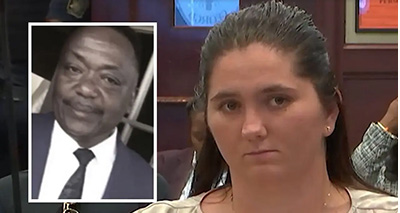
Subscribe to future audio versions of AmRen articles here.
Hannah Payne is a 21-year-old white woman who grew up in Clayton County, Georgia, and then moved to nearby Fayetteville. She loved to help others. She took her niece to afterschool activities when her aunt couldn’t leave work. When her neighbor, a black man, was suffering from cancer and couldn’t maintain his yard, Miss Payne mowed the grass and tended his trees without his even asking. After high school, she got a job with a property-management company and was a hard worker everyone could count on. She worked for a food drive and raised money for the American Heart Association. When her boss was diagnosed with breast cancer, Miss Payne gave pink bracelets to everyone in the office so they could show support. She helped assemble a parade float for a children’s baseball team with which she had no affiliation.
As part of Miss Payne’s property-management job, she had to show vacant apartments — even abandoned apartments that needed renovations — to prospective tenants, so she was alone behind closed doors with strangers. She also collected rent and had to carry large sums of money. After several “unsettling” incidents, she got a concealed carry permit. Her boss knew about this; it was not unusual for people in her field to want protection. Miss Payne took self-defense and firearms training. She bought a Springfield Armory XD handgun (caliber unspecified) and wore it, concealed, every day.
On May 7, 2019, while driving home from work in her Jeep, Miss Payne witnessed an accident after Kenneth Herring, a 62-year-old black man, ran a red light. She called 911 and waited for police to arrive. When Mr. Herring left the scene in his damaged truck, Miss Payne followed him to get his license plate number. A few minutes later, a black man died and a white woman was arrested for murder.
Miss Payne posted $100,000 bond and was released with an ankle monitor on condition that she remained unarmed and have no contact with others involved in the case. A year later, her trial date had not been set, and Herring’s family petitioned the governor and district attorney, claiming that Miss Payne had “racially profiled” Mr. Herring.
After failed attempts to negotiate a plea deal, the case went to trial this month.
The incident happened in Clayton County, which is 73.6 percent black and only eight percent white. Eight men and four women were on the jury; 11 were black and one was white. I watched the trial on video and could not see the jurors, but I am guessing, from her voice, that the lone white juror was a woman.
The judge presiding over the case was a black woman, Jewel C. Scott. One white woman, Bonnie Smith, and one black woman, Nigel Hunter, were prosecutors. Miss Payne’s lawyer, Matthew Tucker, is a white man.
Miss Payne pleaded Not Guilty to the following charges:
- Malice Murder
- Felony murder
- Aggravated assault
- Felony murder with false imprisonment
- False imprisonment
- Possession of firearm while committing a felony
- Possession of a firearm while committing a felony murder
Miss Payne was on the phone with 911 throughout, and there is a recording, but no one who took the stand told the story exactly the way the recording does.
Opening arguments, prosecution
The white prosecutor Bonnie Smith’s first words to the jury were, “On May 7th of 2019, defendant Hannah Renee Payne had the audacity to chase, corner, detain, assault, shoot and kill an unarmed 62-year-old, Kenneth Herring, who was sitting in his own car, all because she didn’t like his driving.”
Miss Smith told the jury that Mr. Herring ran a red light, hitting a tractor trailer. Miss Payne and a black, off-duty prison guard, Terry Robinson, saw the accident. They both pulled over and called 911. Traffic was congested and the emergency response was slow. Mr. Robinson thought Mr. Herring was having a medical emergency. Both Miss Payne and Mr. Robinson placed second calls to 911 20 minutes later because there had been no response. The prosecutor affected a bratty tone and said, “Well, I called you twenty minutes ago,” to demonstrate Miss Payne talking to 911. (She did not have that tone of voice in the 911 recording.)
Mr. Herring then drove away from the scene and Miss Payne followed him. As she left, Mr. Robinson suggested she should get the tag number. Miss Payne was on the phone with 911 as she drove and the operator told her not to chase the pickup truck. The young woman told the operator, “Well, I’m not not going to follow him!”
Prosecutor Smith said witnesses saw her aggressively chase Mr. Herring down and box him in, which she had no right to do because she was not a police officer. She said that the defendant screamed at Mr. Herring, telling him to get out of his car. The prosecutor said because Mr. Herring was trying to defend himself, his car moved forward and hit Miss Payne’s Jeep. Miss Smith disdainfully told the jury that Miss Payne’s vehicle was a “black and pink Jeep,” as though it was a character flaw for a 21-year-old woman to want pink accents on her car. She said Miss Payne was angry that her Jeep had been hit, so she told Mr. Herring, “Get the fuck out of the car! I will shoot you! I will shoot you!”
According to the prosecution, after Miss Payne shot Herring, she picked up her phone and told 911, “He hit my car! He pulled the trigger on my gun and shot himself.”
The prosecutor promised that none of the witnesses saw Mr. Herring harm Miss Payne in any way. The witnesses would also say that Miss Payne was the aggressor. The law would tell them that since she was the primary aggressor, Mr. Herring had the right to defend himself. The prosecutor said Miss Payne could have backed off since police were on the way and Mr. Herring would not get far in a damaged truck.
When police arrived, they asked who shot the man in the truck. Miss Payne politely said, “I did it,” and turned over her gun. Miss Smith promised that video taken by witnesses would show “her audacity, her malice.”
In the opening statement, the prosecution used the word “audacity” so often that a Court TV commentator even said that the prosecutor used “the audacity” attack. Since they were playing to a nearly all-black audience, I wondered if she had found a subtle way to slur Miss Payne without mentioning race. She could have used another word — arrogance, impudence, or cockiness — but audacity might remind jurors of the trendy slang term caucacity, which combines Caucasian and audacity, meaning “audacity stemming from white privilege.” You can even buy a sweatshirt that defines caucasity on Amazon.
Miss Payne’s defense lawyer, Matthew Tucker, opened by saying the prosecution was shooting an arrow into a tree and then painting a bull’s eye around it. He portrayed Hannah Payne as someone who had good intentions, but who got into a bad situation because she was young and naive. His opening was identical to Miss Payne’s testimony, so I will tell the story out of order, and start with her testimony.
Hannah Payne testifies
Miss Payne had to tell the judge officially that she wanted to testify, with the jury out of the room. She started crying during this conversation, and her lawyer asked for a moment so she could compose herself.

Hannah Payne testifying.
On the stand, Miss Payne said she was on her way home from work at an intersection, waiting for the light to turn green, when a red pickup truck ran the red light and crashed into a tractor trailer. The impact made the 18-wheeler sway. Miss Payne had never seen a crash before and had never been in an accident. She pulled over and called 911. Then she went to check on the driver of the semi that was hit, and he said he had had the green light. Another witness, Terry Robinson, went over to tell the semi driver that he had seen the other car run the red light. Mr. Robinson introduced himself to Miss Payne as a “state officer” and flashed a badge. She did not find out until later that he was a prison guard and not a police officer. He told Miss Payne and the semi-driver that he had checked on the man who ran the red light, and he was OK, but he was “definitely inebriated.”
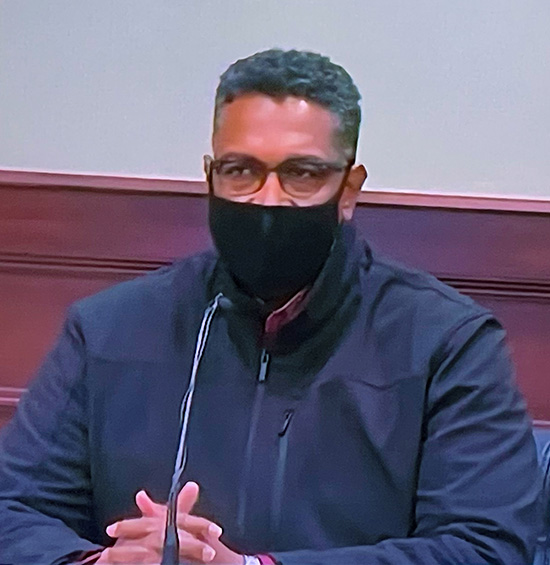
Terry Robinson
Miss Payne and the semi driver both asked, “You mean he’s drunk?”
Kenneth Herring, the driver who ran the red light, got out of his truck. Mr. Robinson was afraid he might be run over and went to Mr. Herring and asked what he was doing. Mr. Herring walked all around his car, inspecting the damage, while Mr. Robinson spoke to him. Miss Payne could not hear the conversation. When Mr. Robinson came back, he gave her a look that she took to mean “something is up” with this guy.
She went back to her car and called her family to tell them what happened. When she noticed Mr. Herring and Mr. Robinson making a lot of hand gestures in a way that suggested “tension,” she made a second 911 call. She saw Mr. Herring get back into his truck, rev the engine, and drive off. She was “shocked” that he would try to drive a car with such heavy damage.
Miss Payne told 911 he was driving away, and the operator asked if she could get the tag number. She couldn’t see it, so she got in her car. Mr. Robinson was standing in the street and he waved her over and then made a motion toward Mr. Herring’s car and said, “Good. Go, go!” She took this to mean that the “state officer” was urging her to go after the red pickup and get the plate number.
Miss Payne told the 911 operator where Mr. Herring was going. Her lawyer asked if the 911 operator told her not to chase the other vehicle, and Miss Payne said she didn’t think she was chasing him, she was just trying to get his tag number, and she thought the 911 operator just wanted her to be safe. She felt safe. After she got close enough to give the plate number, the 911 operator told her that they both should go back to the site of the accident because police were there.
Miss Payne said she saw Mr. Herring stop in a turning lane. She wasn’t sure if he was waiting to turn, or if his truck had “given out” because it was smoking and leaking liquid. She parked, put her phone on speaker, and brought it to Mr. Herring, so he could hear that 911 wanted him to go back to the accident site. She held the phone in a way that Mr. Herring could see that the phone was displaying “911.”
She told Mr. Herring she was on phone with police and they wanted him to go back to the site of the accident. Mr. Herring asked, “Who the fuck are you?” Miss Payne said she was “nobody,” but that 911 wanted them to go back. Then he reached through his car window and knocked the phone out of her hand. He grabbed her by the wrist and by her shirt and pulled her, yelling, “I have something for you, bitch!”
Miss Payne became emotional recalling this, and had to catch her breath. She said he let go of her wrist and grabbed the back of her neck. She screamed, “Let me go!” Then he hit the gas and they lurched forward and ran into her Jeep, which she had parked in front of him. “When you are being held against your will and you have no idea what’s ahead of you, and you’re looking down — it felt like it lasted forever,” she said, tearing up. She said her life flashed before her eyes. She thought he was going to drive away, dragging her along. She yelled “Get the F out of the car!” because she did not want to be dragged.
She needed a tissue and sniffled on the stand.
The defense attorney showed the jury the black shirt she had been wearing that night, which was torn down the front. He showed photos of scratch marks on the back of her neck, on her arms and her chest. He showed photos of her bruised, swollen wrist, hand, eye and upper lip. She said all this bruising had been painful.
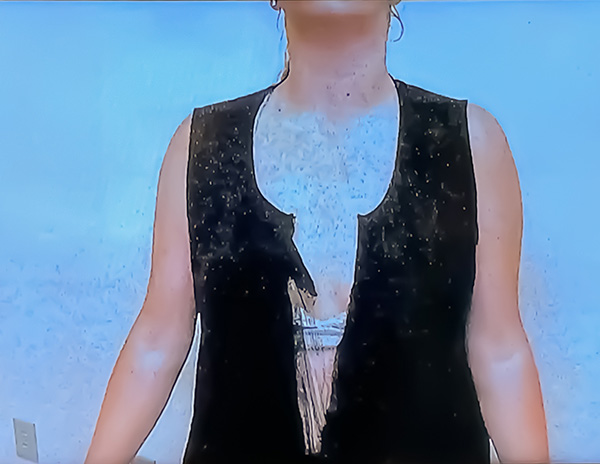
The torn shirt
Miss Payne saw Mr. Herring reach behind himself. He “mashed the gas” and she heard his truck revving and liquids spewing. She tried to pull away and said, “I have a gun!” She hoped he would let her go if he knew she was armed. She drew her gun with her right hand. Mr. Herring let go of her neck and tried to yank her gun away. With his hands on her hand and the gun, he twisted her wrist back.
Mr. Tucker gave Miss Payne a toy gun so she could show how she was holding it. She said her finger was not on the trigger because she was taught not to until she was ready to shoot. She said she was yelling “Stop! Stop! Stop!” and her face was against the door of the car when she heard the gun go off. She stumbled backwards, found her phone on the ground, and told the 911 operator what happened.
Mr. Tucker asked if she looked for shell casings and she said she did not. She told 911 that the man pulled her trigger. She saw other people nearby and asked if they would stay and be witnesses. Someone asked Miss Payne if she was OK; she answered that she was, but he was not. She said she asked 911 to send an ambulance for him.
People gathered around, asking each other what happened. She holstered her gun, took it off her hip, and flagged down a cop to turn over the gun. A woman asked Miss Payne, “Did you just shoot him?”
Miss Payne said she answered, “No.”
She consistently said that she had never had her finger on the trigger. When her lawyer asked why, Miss Payne answered, “Number one, from training. And number two, I never had any intention of pulling the trigger.”
The cop who took her gun went to Mr. Herring’s truck. Police told her she would be detained until they could figure out what happened. They put her in the back of their car. Miss Payne said she did not think of rendering aid to Mr. Herring because she had been trying to get away from Mr. Herring’s vehicle and did not want to go back to it.
Her lawyer showed a video of her, sitting in the police car, with her hands cuffed behind her, as she told a black police officer the same story she told on the stand, minus some details. Miss Payne told the court she was overwhelmed and scared. Her lawyer showed a photo of a knife that was found inside Mr. Herring’s vehicle, but Miss Payne said she hadn’t seen the knife.
She talked about being questioned by two detectives at the police station, a black man and a white woman: “They kept asking the same things over and over again, but every time they asked me, they would kind of insinuate a different narrative.” She thought the cops were trying to twist her words. For example, when she told them she stood on the side of Mr. Herring’s vehicle to show him her phone, they said, “so you reached into his vehicle to show him your phone?”
Miss Payne said at first, she thought she was just giving a statement about what happened and thought her side of the story was obvious. Then she realized she was being interrogated and was under suspicion. Mr. Tucker asked if they were playing a good-cop-bad-cop and Miss Payne said yes.
Her lawyer asked her what she learned from this experience, and Miss Payne said, “Not everybody is going to have a reaction that you think they’re going to have. And that, clearly, trying to do the right thing is not the right answer.” She added that she would never try to help anyone again.
Cross examination of Hannah Payne
Black prosecutor Nigel Hunter cross examined Miss Payne. The witness said she could not smell alcohol on Mr. Herring, and she did not see that he had a weapon. Miss Payne also said that Terry Robinson, the “state officer” had not actually told her to get Mr. Herring’s license plate number. Miss Payne’s memory was faulty; in a 911 call played for the jury, Mr. Robinson says, “Go get the tag!”
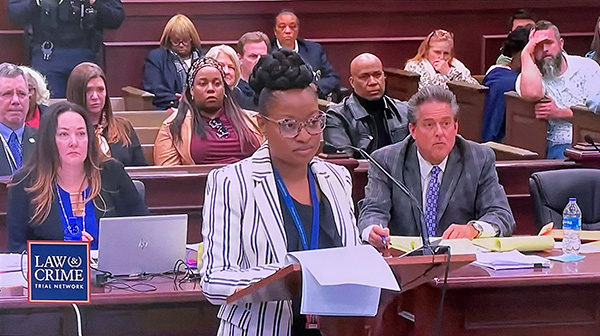
Prosecutor Nigel Hunter
Miss Hunter asked if 911 told her four times not to chase the vehicle. Miss Payne said that was incorrect.
Miss Hunter reviewed a portion of the 911 call transcript. The operator says, “We do not want you to chase him. We want you to stay safe,” and Miss Payne replies, “I understand 100 percent.” She explained that she thought dispatch just wanted her to be safe. She didn’t think she was actually chasing Mr. Herring. Perhaps she thought you have to be speeding to “chase” another vehicle.
Miss Hunter pointed out that after both vehicles came to a stop and Miss Payne gave dispatch the tag number, she was told: “Go back to that location where the incident happened, because someone is actually on the way to you guys now.”
Miss Hunter said “there should be no confusion” that Miss Payne should go back by herself. Miss Payne said that’s not what the dispatcher’s next words were. She understood that they were both supposed to return, and thought she was supposed to tell Mr. Herring.
Miss Hunter read Miss Payne’s words from the 911 transcript: “I am not not going to follow him because he is going to cause another accident. So, I will stay behind him until an officer can get to us. But until then, I’m not moving.”
Then the dispatcher’s words were read: “I want you guys to go back to the location where it happened and an officer will be there momentarily.” Miss Payne thought she was supposed to tell Mr. Herring that they should both drive back to the accident location.
The prosecutor asked, “Is it your testimony today that you did not attempt to stop this vehicle?” “Correct,” Miss Payne answered.
Miss Hunter showed a photo of Miss Payne’s Jeep parked in front of Herring’s truck, crashed into the Jeep. She pointed out that the Jeep’s front wheel was turned toward Mr. Herring’s truck.
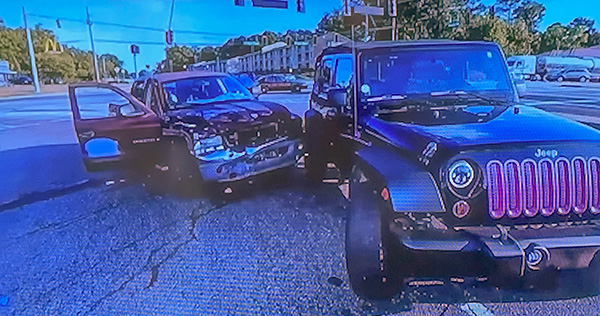
The prosecution brought out the transcript of Miss Payne’s interview with the detectives about her struggle with Mr. Herring. She was quoted as saying, “After he tried to pull the trigger when he came back around is when I had my hand on the trigger, he still was squeezing, reaching, pulling and turning.” Miss Payne explained that earlier in the interview, they were talking about the “trigger guard,” and that’s what she meant. She said she had been trained to keep her finger on the guard if she was not ready to shoot.
The prosecution asked why she got so involved; her car wasn’t damaged in the initial collision. Miss Payne said she did what she would want someone else to do for her. She thought she was doing what 911 wanted.
Miss Hunter asked Miss Payne what she could have done to avoid the situation. Miss Payne said it could have been avoided if she had “not tried to do the right thing.” She said the gun would not have gone off if Mr. Herring had not tried to grab it from her.
The prosecutor said, “This could have been avoided if you had not introduced a gun into this incident, correct?” Miss Payne responded, “I introduced the gun to try to save my life.”
Continued in Part II.















